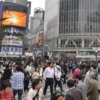The economy of Japan is one of the strongest in the world. It is the second largest economy in the world, after the United States.
Japan’s economy has a well-educated work force and high levels of savings.
Japan has very little natural resources. That’s why the economy of Japan depends on importing raw materials such as oil, food and wood.
Japan has a variety of advanced industries that are highly successful. Japan’s main export includes cars, electronic devices and computers. Most important trade partner is the USA which imports more than one quarter of all Japanese exports.
Only 12% of Japan’s land is suitable for agriculture. Due to this lack of land, farmers use a system of terraces to farm in small areas. Although the economy of Japan is usually self-sufficient in rice, it must import about 50% of other grains and relies on import for most of its supply of meat.
Japan has one of the world’s largest fishing fleets and accounts for nearly 15% of the global catch.
One major long-term concern for the Japanese labor force is a low birthrate. The decline in population already started in 2005, when the number of deaths in Japan was larger than the number of births. Allowing more immigration is not an option favored in Japan.
Lifetime employment and seniority-based advancement have been common in the economy of Japan. Recently these norms begun to change.
Karoshi is death due to overwork. The major medical causes of Karoshi deaths are heart attack and stroke due to stress. Suicides resulting from work failures are also very common.
Women participate in the work force, but they usually leave their jobs once they get married. Recently, some of the country’s corporate giants have become more flexible regarding women’s working hours, and even supply daycare for children – enabling mothers to keep their jobs.
Japan And Their Economy Today
For the last three decades, Japan’s economic growth had been spectacular – a 10% average in the sixties, a 5% average in the seventies, and a 4% average in the eighties.
Recently – affected by the global economic crisis, Japan’s economy is shrinking at the fastest rate in 35 years (since after the oil shock in 1974).
Japan’s central bank lowered its key interest rate to 0.1 percent in December.
“There is no question that this is the worst economic crisis since the end of World War II,” said Economy Minister Kaoru Yosano lately.
Lately, electronics Company Pioneer Corp. said it will cut 10,000 jobs globally, joining a growing list of corporate giants like Sony which is releasing 8,000 workers, Nissan Motor Co. and NEC Corp. which are dismissing 20,000 people each.
History Of Economy In Japan
The economic history of Japan is very impressing due to its spectacular growth – once during the Meiji restoration (1868 through World War II), and the second time which began in 1945 and continued into the eighties.
From the Meiji Restoration to World War II – in order to stop the influence of Christianity, the Tokugawa shoguns adopted a policy of isolation and banned all international trade. The Japan history was cut off from the rest of the world. All the progress made by western world between 17th and 19th century was unknown in the history in Japan. History in Japan had its own feudal system of samurai, farmers, craftsmen, and merchants.
In 1853, Commodore Perry of the U.S. Navy forced the shogun to enter into a trade agreement with the U.S.
In 1868 – Emperor Meiji set Japan on a course of modernization that would transform the economy of Japan from a feudal society to an industrialized nation in only a few decades. A new Western-based education system was formed, thousands of students were sent to the United States and Europe, and Japan hired more than 3,000 Westerners to teach modern science and foreign languages in Japan.
The government built factories and shipyards that were sold to entrepreneurs at a very low price. Many of these businesses grew rapidly into the larger conglomerates.
Post-war economic history – 1945 into the eighties – From the sixties to the eighties economic growth in Japan has been called a miracle – 10% average in the sixties, 5% average in the seventies and 4% average in the eighties.
Growth slowed in the late nineties, due to the sliding stock and real estate prices. This was the end of “the bubble” of the eighties, and marked a decade of stagnant economic growth. Government efforts to revive the economic growth had little success. Japanese government financed large public projects.
The economy of Japan deteriorated even more during 2000 – 2001 by the slowing of global economy.
In 2005 the economy finally began to show signs of recovering. In July 2006, the zero-rate policy was ended. Please note: the pictures at this page are provided under several Creative Commons licenses.
Return from Economy Of Japan to TokyoTopGuide Homepage



